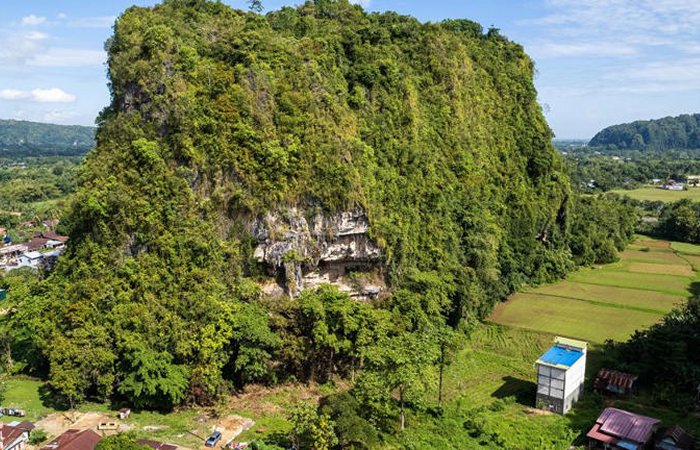World’s Oldest ‘Picture Story’ Found Deep Inside Indonesian Cave
Jan Bartek - AncientPages.com - Storytelling has been with humanity as long for as anyone can remember. Before the development of written language and paper, our ancestors utilized various methods to preserve and share their stories, including rock art and oral traditions passed down through generations.
An aerial shot of Karampuang Hill where the cave site is located. Credit: Google Arts & Culture
Recently, a groundbreaking discovery has been made in an Indonesian cave that may provide the earliest known evidence of storytelling in art. A research team comprising experts from Australia's Griffith University, the Indonesian National Research and Innovation Agency (BRIN), and Southern Cross University has uncovered and dated a remarkable cave painting on the Indonesian island of Sulawesi.
The artwork, located in the limestone cave of Leang Karampuang in the Maros-Pangkep region of South Sulawesi, depicts three anthropomorphic figures interacting with a wild pig. The team employed an innovative technique called laser ablation U-series (LA-U-series) analysis to ascertain its age. This method allowed them to date minuscule layers of calcium carbonate that had formed on top of the painting over time.
The results of this analysis are truly astounding. The underlying artwork has been determined to be at least 51,200 years old, making it the world's oldest reliably dated cave art image. Furthermore, it represents the earliest known example of narrative art found anywhere on Earth.
“We have previously used the uranium-series method to date very old rock art in two parts of Indonesia, Sulawesi, and Borneo, but our new LA-U-series technique is more accurate, allowing us to date the earliest calcium carbonate layers formed on the art and get closer to the point in time the art was created. It will revolutionize rock art dating,” Professor Maxime Aubert, a specialist in archaeological science at Griffith Centre for Social and Cultural Research (GCSCR). said.
The painting depicts three human-like figures interacting with a wild pig. Credit: Griffith University
“The innovative technique we’ve pioneered enables us to create detailed ‘maps’ of calcium carbonate layers. This capability empowers us to pinpoint and steer clear of regions affected by natural diagenesis processes, which stem from intricate growth histories. Consequently, our age determinations for rock art become more robust and dependable,” explained Professor Renaud Joannes-Boyau an expert in archaeogeochemistry in the Geoarchaeology and Archaeometry Research Group (GARG).
According to Adhi Agus Oktaviana, an Indonesian rock art specialist from the National Research and Innovation Agency (BRIN) in Jakarta and PhD student in the Griffith Centre for Social and Cultural Research (GCSCR), the discovery that the Leang Karampuang painting is at least 51,200 years old has important implications for our understanding of the origin of early art.
“Our results are very surprising: none of the famous European Ice Age art is anywhere near as old as this, with the exception of some controversial finds in Spain, and this is the first-time rock art dates in Indonesia have ever been pushed beyond the 50,000-year mark,” Oktaviana said.
The LA-U-series dating technique revealed that a cave painting in Leang Bulu' Sipong 4, Maros-Pangkep, is approximately 48, 000 years old, 4, 000 years older than previously estimated. The artwork depicts therianthropes hunting animals, challenging the view that early cave art lacked narrative elements.
Professor Adam Brumm from Griffith’s Australian Research Centre for Human Evolution (ARCHE), who co-led the study, highlights this as the oldest known Sulawesi cave art showing human-animal interactions, suggesting early storytelling in Indonesian art.
This discovery predates similar European evidence, implying that pictorial storytelling emerged earlier than thought. Oktaviana notes it as the oldest archaeological evidence of narrative depiction, dated around 51 200 years ago.
See also: More Archaeology News
“Humans have probably been telling stories for much longer than 51,200 years, but as words do not fossilise we can only go by indirect proxies like depictions of scenes in art – and the Sulawesi art is now the oldest such evidence by far that is known to archaeology,” Oktaviana said.
This finding offers insights into prehistoric human cognitive development and artistic expression, revealing the complex cultural practices of our early ancestors.
The study was published in the journal Nature
Written by Jan Bartek - AncientPages.com Staff Writer






















